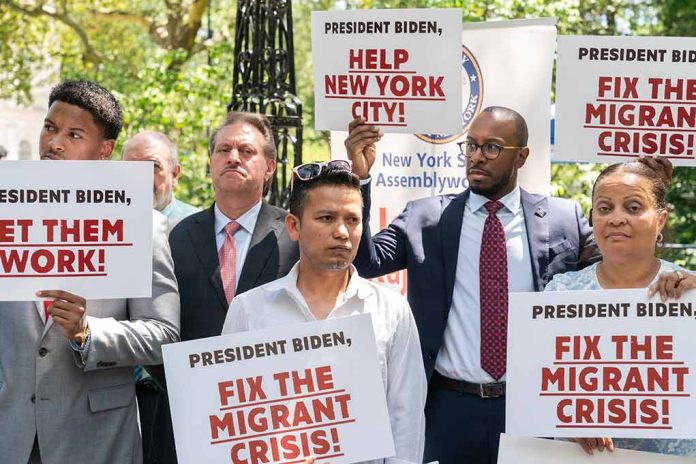
New York City’s migrant housing crisis deepens as hotel rooms become temporary shelters, costing billions.
At a Glance
- NYC seeks 14,000 hotel rooms to house migrants through 2025, costing $2.3 billion
- Over 200,000 migrants have arrived in NYC since 2022
- More than 150 hotels are currently housing migrants at an average cost of $352 per room per night
- Mayor Eric Adams faces criticism for the ballooning costs and management of the crisis
NYC’s Costly Solution to Migrant Housing
New York City’s approach to housing the influx of migrants has come under intense scrutiny as costs soar and solutions remain elusive. Mayor Eric Adams is facing mounting criticism as the price tag for housing migrants approaches $2.3 billion, with projections reaching a staggering $5.76 billion by the end of next year. The city has turned to hotels as a temporary fix, seeking 14,000 rooms to accommodate the continuous flow of new arrivals.
Since 2022, over 200,000 migrants have arrived in New York City, many transported by GOP governors from the southern border. This unprecedented influx has stretched the city’s resources to their limits, forcing officials to implement creative but costly solutions. Currently, more than 150 hotels across the city are being used to house migrants, with an average nightly cost of $352 per room.
From Luxury to Necessity: Hotels Repurposed
Iconic establishments like the Row NYC Hotel in Times Square and the Roosevelt near Grand Central have been transformed into temporary shelters. While this strategy provides immediate housing for migrants, it raises concerns about the long-term impact on the city’s vital tourism industry. The New York City Department of Homeless Services is actively seeking a contractor to manage the acquisition of these hotel rooms, highlighting the scale of the operation.
“The taxpayers can’t pay for this indefinitely,” Nicole Gelinas of the Manhattan Institute think tank told the NY Post. “We should stop using hotels as shelters by the end of the year.”
The financial strain is evident, with City Comptroller Brad Lander reporting that DocGo Inc billed the city $1.7 million for vacant hotel rooms supposedly housing migrants. Such incidents have fueled public outrage and demands for greater accountability in the management of resources.
Shifting Strategies and Closures
As the city grapples with the ongoing crisis, changes are being implemented. The largest shelter on Randall’s Island, notorious for violence, is being dismantled with plans to close by March. This move is part of a broader strategy to address the migrant crisis more effectively.
“The ability to close the Randall’s Island humanitarian relief center marks the latest milestone we have reached as an administration addressing this humanitarian crisis,” said the Mayor’s asylum seeker chief, Molly Schaeffer.
Mayor Adams has taken controversial steps to alleviate the financial strain, including abandoning the Right to Shelter law and reducing shelter stay limits. These measures have helped decrease the number of migrants being sheltered for 14 consecutive weeks. However, the city continues to rely heavily on hotels as emergency shelters, seeking a contract for 14,000 rooms through next year.
Financial Implications and Future Outlook
The financial implications of this crisis are far-reaching. While the city’s Asylum Funding Tracker indicates a projected decrease in migrant shelter costs from $1.51 billion last year to $233 million by the fiscal year ending June 30, 2025, the overall expense remains significant. The New York City Hotel Association, which manages three migrant housing contracts, is applying for a new contract, highlighting the ongoing need for accommodation solutions.
As New York City continues to navigate this complex crisis, the balance between providing necessary shelter and managing fiscal responsibility remains a significant challenge. The use of hotels as temporary shelters, while providing immediate relief, raises questions about long-term sustainability and the impact on the city’s economy. As the situation evolves, city officials, policymakers, and residents alike will be watching closely to see how this unprecedented challenge is addressed in the coming months and years.
Sources:
- https://www.dailymail.co.uk/news/article-13943891/NYC-migrants-hotel-rooms-adams-Randalls.html
- https://www.nytimes.com/2023/03/23/nyregion/nyc-hotels-homeless-shelters.html
- https://nypost.com/2024/10/09/us-news/nyc-seeking-14000-hotel-rooms-to-shelter-migrants-through-2025/
- https://comptroller.nyc.gov/reports/comparing-per-diem-hotel-and-service-costs-for-shelter-for-asylum-seekers/
- https://invisiblepeople.tv/the-harsh-reality-of-nycs-migrant-shelter-dilemma/
- https://winnyc.org/wp-content/uploads/2023/08/Housing-Instead-of-Emergency-Shelter-for-Asylum-Seekersbriefv4.pdf
- https://vinnews.com/2024/10/09/nyc-to-extend-use-of-hotels-for-migrant-shelters-through-2025-costing-billions-report/
- https://mishtalk.com/economics/one-of-every-five-new-york-city-hotels-is-now-a-migrant-shelter/
- https://www.sir.advancedleadership.harvard.edu/articles/moral-economic-answer-nyc-homelessness-isnt-shelter-its-housing
- https://www.migrationpolicy.org/article/us-cities-innovations-integrate-arrivals










